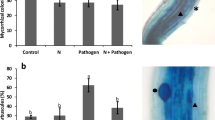Abstract
This study sought to investigate the effect of sulfur levels on changes in the fungal community composition of arbuscular mycorrhizae (AM) at the pod-setting stage and the relationship between the amount of applied sulfur and AM fungal diversity in different soybean cultivars. The objective of the research was to determine the optimal sulfur application level for different soybean cultivars and to improve soybean yield and quality from the perspective of AM fungal diversity. Three soybean cultivars, Heinong 44, Heinong 48, and Heinong 37, were selected as study materials. In addition to 0.033 g each of N, P2O5 and K2O per kg of soil, 0, 0.02, 0.04, or 0.06 g of elemental sulfur was applied to each kg of soil for the four treatment groups, S1, S2, S3, and S4, respectively. The AM fungal community structure was analyzed in the soil and root of different soybean cultivars using the PCR-DGGE technology. The results indicated a significant effect of sulfur on the AM fungal community structure in the roots and rhizospheric soil of different soybean cultivars. The three soybean cultivars in group S2 exhibited the highest diversity in AM fungus. Significant changes in the dominant fungal species were observed in the DGGE fingerprints of each sample, and Glomus, Funneliformis, Rhizophagus, and Claroideoglomus fungi were the dominant species of AM fungus in the roots and soil of soybean. The application of an appropriate amount of sulfur improved the diversity of AM fungi in roots and rhizospheric soil of different soybean cultivars.



Similar content being viewed by others
References
Andrés PS, María Luis SM, Andrés PP, Rosario A (2009) Arbuscular mycorrhizal fungi increased growth, nutrient uptake and tolerance to salinity in olive trees under nursery conditions. J Plant Physiol 166(13):1350–1359
Cai BY, Jie WG (2009) Detection of the arbuscular mycorrhizal fungi in the rhizosphere of soybean. Soybean Sci 28(3):483–486
Cai BY, Ge JP, Jie WG, Yan XF (2009) The community composition of the arbuscular mycorrhizal fungi in the rhizosphere of Phellodendron amurense. Mycosystema 28(4):512–520
Chi FQ, Wei D, Shen HB (2003) Study on the sulfur status in cultivited soils of Heilongjiang Province. Chin J Soil Sci 34(3):209–211
Daei G, Ardekani MR, Rejali F, Teimuri S, Miransari M (2009) Alleviation of salinity stress on wheat yield, yield components, and nutrient uptake using arbuscular mycorrhizal fungi under field conditions. J Plant Physiol 166(6):617–625
Gyuricza V, Declerck S, Boulois HD (2010) Arbuscular mycorrhizal fungi decrease radiocesium accumulation in Medicago truncatula. J Environ Radioact 101(8):591–596
Hijri M, Niculita H, Sanders IR (2007) Molecular characterization of chromosome termini of the arbuscular mycorrhizal fungus Glomus intraradices (Glomeromycota). Fungal Genet Biol 44:1380–1386
Jeff RP, Rachel GC, Kari ED, Robert HG, Miranda MH, David JL, John NK, Pauls KP, Clarence JS, Jack TT, Pedro MA (2009) Effect of glyphosate on the tripartite symbiosis formed by Glomus intraradices, Bradyrhizobium japonicum, and genetically modified soybean. Appl Soil Ecol 41(1):128–136
Jie WG, Cai BY, Ge JP, Yan XF (2008) Studies on PCR denaturing gradient gel electrophoresis conditions of arbuscular mycorrhizal fungi of Phellodendron amurense Rupr. J Nat Sci Heilongjiang Univ 25(4):534–538
Krüger M, Krüger C, Walker C, Stockinger H, Schüßler A (2012) Phylogenetic reference data for systematics and phylotaxonomy of arbuscular mycorrhizal fungi from phylum to species level. New Phytol 193:970–984
Li JF, Zhang YL, Wang JK (2004) Study on the effect of sulfur on the growth and physiology of soybean. Chin J Soil Sci 35(5):612–616
Long LK, Yang SZ, Yao Q, Zhu HH (2005) DNA extraction from arbuscular mycorrhizal fungi and analysis by PCR-denaturing gradient gel electrophoresis. Mycosystema 24(4):564–569
Louisa RB, Grzyb I, Jeffries P (2009) Shifting the balance from qualitative to quantitative analysis of arbuscular mycorrhizal communities in field soils. Fungal Ecol 2:1–9
Ma WK, Siciliano SD, Germida JJ (2005) A PCR-DGGE method for detecting arbuscular mycorrhizal fungi in cultivated soils. Soil Biol Biochem 37(9):1589–1597
Mozafar S, Mahlagha G, Hassan E (2007) Improved growth of salinity stressed soybean after inoculation with salt pre-treated mycorrhizal fungi. J Plant Physiol 164(9):1144–1151
Taheri WI, Bever JD (2010) Adaptation of plants and arbuscular mycorrhizal fungi to coal tailings in Indiana. Appl Soil Ecol 45(3):138–143
Violi HA, Alejandro F, Wright SF, Esteban EP, Joseph BM, John AM, Carol JL (2008) Disturbance changes arbuscular mycorrhizal fungal phenology and soil glomalin concentrations but not fungal spore composition in montane rainforests in Veracruz and Chiapas, Mexico. For Ecol Manag 254:276–290
Wang FY, Lin XG (2008) Effect of arbuscular mycorrhizal fungi on quality safety of farm products in contaminated soils. Acta Pedol Sin 45(6):1142–1147
Yu YG, Zhao B (2008) The interaction and effect of two species of arbuscular mycorrhizal fungi on the growth of Astragalus sinicus L. at different pH level. Mycosystema 27(2):209–216
Zarei M, Hempel S, Wubet T, Schäfer T, Savaghebi G, Jouzani GS, Nekouei MK, Buscot F (2010) Molecular diversity of arbuscular mycorrhizal fungi in relation to soil chemical properties and heavy metal contamination. Environ Pollut 158(8):2757–2765
Zhang XH, Zhu YG, Wang YS (2006) Effect of long-term fertilization on the diversity and distribution of arbuscular mycorrhiza fungi in Northeast China. Acta Ecol Sin 26(9):3081–3087
Acknowledgments
This study was supported by a grant from Natural Science Foundation of China (No. 31170466), Heilongjiang Provincial Natural Science Foundation (No. C200918), Science and Technology Project from Heilongjiang Provincial Education Department (No. 12521394), the Research Fund of Heilongjiang Provincial Education Department (No. 10543074), and High-level Personnel Supported Program of Heilongjiang University (ecological restoration team Hdtd 2010–12).
Author information
Authors and Affiliations
Corresponding author
Rights and permissions
About this article
Cite this article
Jie, W., Cai, B., Zhang, Y. et al. The Effect of Sulfur on the Composition of Arbuscular Mycorrhizal Fungal Communities During the Pod-Setting Stage of Different Soybean Cultivars. Curr Microbiol 65, 500–506 (2012). https://doi.org/10.1007/s00284-012-0183-7
Received:
Accepted:
Published:
Issue Date:
DOI: https://doi.org/10.1007/s00284-012-0183-7




